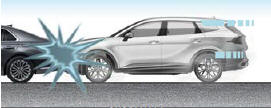Kia Sportage: Air bag collision sensors

* The actual shape and position of sensors may differ from the illustration.
- Supplemental Restraint System (SRS) control module/rollover sensor
- Front impact sensors
- Side pressure sensors (front door)
- Side impact sensors (B-pillar)
- Side impact sensors (C-pillar)
WARNING
Air bag sensors
- Do not hit or allow any objects to
impact the locations where air bags or
sensors are installed.
This may cause unexpected air bag deployment, which could result in serious personal injury or death.
- If the installation location or angle of
the sensors is altered in any way, the
air bags may deploy when they
should not or they may not deploy
when they should.
Therefore, do not try to perform maintenance on or around the air bag sensors.
Have the vehicle checked and repaired by an authorized Kia dealer.
- Do not arbitrarily touch the front impact sensors. When the angle of the sensor is changed, the air bag system may malfunction.
Problems may arise if the sensor installation angles are changed due to the deformation of the front bumper, front end module, body or front doors where side collision sensors are installed. Have the vehicle checked and repaired by an authorized Kia dealer.
Installing bumper guards (or side step or running board) or replacing a bumper (or front door module) with non-genuine parts may adversely affect your vehicle's collision and air bag deployment performance.
Why didn't my air bag go off in a collision? (Inflation and non-inflation conditions of the air bag)
There are many types of accidents in which the air bag would not be expected to provide additional protection.
These include rear impacts, second or third collisions in multiple impact accidents, as well as low speed impacts.
Air bag inflation conditions
Front air bags

Front air bags are designed to inflate in a frontal collision depending on several factors, including the severity of impact of the front collision.
Side and curtain air bags

* The actual air bags in the vehicle may differ from the illustration.
Side and/or curtain air bags are designed to inflate when an impact is detected by side collision sensors depending on several factors, including the severity of impact resulting from a side impact collision.
Also, the side and curtain air bags are designed to inflate when a rollover is detected by a rollover sensor.
Although the front air bags (driver's and front passenger's air bags) are primarily designed to inflate in frontal collisions, they may inflate in other types of collisions if the front impact sensors detect a sufficient frontal force in another type of impact.
Similarly, although side and curtain air bags are designed to inflate in certain side impact collisions, they may inflate in other types of collisions where a side force is detected by the sensors. For instance, side air bag and/or curtain air bags may inflate if rollover sensors indicate the possibility of a rollover occurring (even if none actually occurs) or in other situations, including when the vehicle is tilted while being towed.
Even if side and/or curtain air bags do not provide impact protection in a rollover, they will deploy to prevent ejection of occupants, especially those who are restrained with seat belts.
If the vehicle chassis is impacted by bumps or objects on unimproved roads, the air bags may deploy. Drive carefully on unimproved roads or on surfaces not designed for vehicle traffic to prevent unintended air bag deployment.
READ NEXT:
 Air bag non-inflation conditions
Air bag non-inflation conditions
Air bags may not deploy in certain
low-speed collisions where the air bag
would not add any benefit beyond the
protection already offered by the seat
belts.
Front air bags are not design
 Supplemental Restraint System (SRS) care
Supplemental Restraint System (SRS) care
The Supplemental Restraint System
(SRS) is virtually maintenance-free and
so there are no parts you can safely service
by yourself.
If the SRS air bag warning light does not
appear, or continuo
SEE MORE:
 Fuel Tank
Fuel Tank
Repair procedures
Removal
1. Release the residual pressure in fuel line (Refer to "Release Residual
Pressure in Fuel Line" in this group).
2. Remove the rear seat cushion (Refer to "Seat" in BD group).
3. Remove the fuel pump service cover (A).
4. Disconnect the fuel рumр connector
 Audio system
Audio system
NOTICE
If you install an aftermarket HID headlamp,
your vehicle's audio and electronic
device may malfunction.
* If your vehicle is equipped with infotainment
system, refer to a separately
supplied manual for detailed information.
Sharkfin antenna
The sharkfin antenna transmits and
Content
- Home
- Kia Sportage - Fifth generation (NQ5) - (2022-2025) - Owner's Manual
- Kia Sportage - Second generation (JEKM) (2005-2015) - Body Workshop Manual
- Kia Sportage Third generation (SL) - (2011-2016) - Service and Repair Manual
- Sitemap
- Top articles